

The narrower the step and the wider the gap, the lower the pulse intensity and the less energy is available to the fan. One cycle is always the same width (that is, it takes the same time, for example 4 ms) and is filled by a gap (0 V) and a step (12 V). This is well illustrated in the graph below. How much power is available to it is expressed by the ratio of “powered” to “unpowered” within one cycle. In layman’s terms, you could say that the fan is being powered for a while and then not for a while.

In other words, the voltage is “intermittent”, but at very high frequencies, so it usually doesn’t bother the end device in any way. Naturally, electrical voltages are also used in PWM control, except that, unlike linear (DC direct current) control, they are dispensed in pulses of varying width. I am referring to the frequent conflation and division of these types of regulation into “PWM and voltage”.

Emphasizing something like this sounds rather absurd, but from some interpretations available on the internet one may get the impression that PWM uses something other than voltage to supply power. The goal is that everyone will know the answer at the end, even if most of our readers know what PWM control is and why it is preferable to linear control.įirst of all, it is good to understand that not only DC but also PWM control works with voltage. We will work our way across the article to the answer to the headline question. Related to this in computers is the strong disproportion of 3-pin to 4-pin fans, of which there are considerably more. In this article, we will explain in the simplest possible terms the reason why PWM regulation is gradually replacing linear regulation. We’re talking about pulse-width modulation for voltage regulation.

We avoid it like the plague when it comes to backlighting LCD monitors, but we can’t imagine the best fans without it. What is the difference between impulse and linear control? Focused on fans


 0 kommentar(er)
0 kommentar(er)
